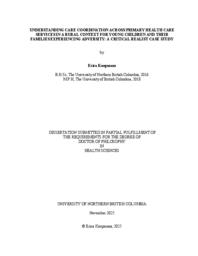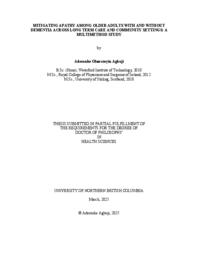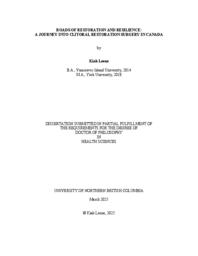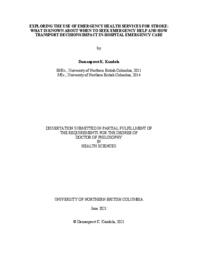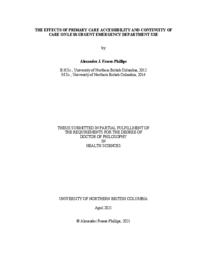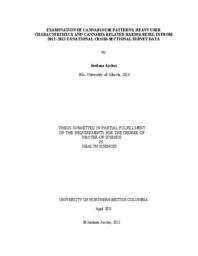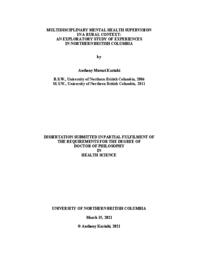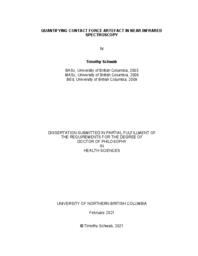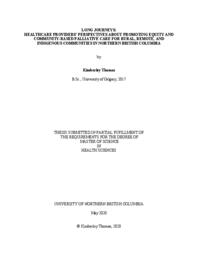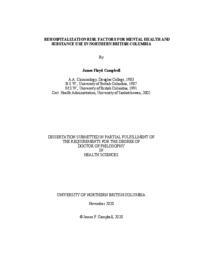University of Northern British Columbia. Health Sciences
Related Works
Content type
Digital Document
Origin Information
Content type
Digital Document
Origin Information
Content type
Digital Document
Origin Information
Content type
Digital Document
Origin Information
Content type
Digital Document
Origin Information
Content type
Digital Document
Description / Synopsis
Transport practices for seeking emergency stroke care remain largely underresearched and poorly understood, particularly for individuals living in small urban, rural, and remote regions. This multi-method study aims to address this knowledge gap and explores the impact of mode of transport on in-hospital stroke care and the decision-making process of seeking emergency medical attention for patients and their caregivers. Data from the Discharge Abstract Database provide information on stroke-related use of emergency health services across British Columbia. Data from the Canadian Institutes for Health Information Special Project 340 provide information on if calling emergency health services impacts the delivery of care, including the completion of neuroimaging, the administration of acute thrombolysis, and the prescription of antithrombotics upon discharge across a northern health region. Focused, semi-structured interviews provide contextual insight into the decision-making processes for seeking emergency stroke care among patient and caregiver participants in a northern health region. Stroke-related emergency health service use across British Columbia from January 2015 to March 2018 was 67.9% (N=19,849), ranging from 58.8% in Northern Health to 70.2% in Fraser Health. In Northern Health (N=784), there were differences between health service delivery areas for stroke-related emergency health service use ranging from 53.7% in the Northwest to 64.8% in the Northern Interior from January 2015 to March 2018. Similar differences in thrombolytic therapy administration and the prescription of antithrombotics were noted. The odds of emergency health service use were greater for those 65 years of age and older than those younger than 65 and lower for those in the Northwest health service delivery area than those in the Northern Interior health service delivery area. Differences were found for the completion of neuroimaging between males and females. Interviews for patient (n=12) and caregiver (n=7) participants provide complementary contextual insights and yielded three key themes, including the decision-making process following a stroke, experiences of care, and perceived gaps and areas in need of further support. This integrated knowledge translation-informed and practice-driven research addresses health services and policy priorities. Findings are anticipated to help inform the development and refinement of emergency health services in British Columbia by highlighting differences in emergency health services use across geographies and identifying factors that inform patient decisionmaking when seeking emergency medical attention.
Origin Information
Content type
Digital Document
Description / Synopsis
Background/Aims. Since the early 2000s, Canada’s primary care system has undergone substantial reforms, including the incorporation of interdisciplinary teams and strategies to optimise accessibility. However, the effects of primary care accessibility and continuity of care on less-urgent emergency department (ED) use are unclear. Three studies were undertaken to investigate the effects of primary care accessibility and continuity of care factors on less-urgent ED use. Methods. Study One employed a cross-sectional analysis of responses to the Canadian Survey of Experiences with Primary Health Care to predict self-reported ED visit avoidability; Study Two employed a longitudinal time-to-event analysis of responses to Ontario’s Health Care Experience Survey linked with subsequent National Ambulatory Care Reporting System data to predict medically assessed less-urgent ED use; and Study Three employed time-series analyses of presentations to two northern British Columbia EDs following changes in walk-in clinic coverage. Results. Study One (n = 2,625) found no significant associations between self-reported ED visit avoidability and all measures of primary care accessibility and continuity of care. However, rural respondents reported greater ED visit avoidability. Conversely, Study Two (n = 34,686) found that all accessibility factors were significantly associated with medically assessed less-urgent ED use, including the presence of a regular PCP, the regular source of care, and the availability of after-hours care through the PCP. However, time with the same PCP was not associated with medically assessed less-urgent ED use. Rurality was also found to moderate the effect of after-hours care accessibility, with only rural respondents reporting a beneficial effect. Finally, Study Three found that changes in walk-in clinic coverage resulted in short-term impacts on less-urgent ED use, with a walk-in clinic closure resulting in an immediate increase in less-urgent presentations and an opening resulting in an immediate decrease. Conclusions. The findings of Studies Two and Three provide evidence that primary care accessibility factors are associated with medically assessed less-urgent ED use; however, the findings of Study One suggest that these factors do not influence self-perceived ED visit avoidability. Future studies should consider this discordance when measuring the impact of primary care accessibility on less-urgent ED use.
Origin Information
Content type
Digital Document
Description / Synopsis
This thesis aimed to examine cannabis use patterns by quantity in the United States, identify key characteristics of the heaviest cannabis users, and conduct an initial assessment of whether the prevention paradox may hold for cannabis use in the United States. Using data from the National Epidemiologic Survey on Alcohol and Related Conditions – III, findings suggest that a small portion of the cannabis-using population consumes the majority of the yearly cannabis supply in the United States. Characteristics that affect the odds of being a heavy cannabis user include age, sex, personal income, education level, age of initiation, and the presence of a cannabis use or nicotine use disorder. A larger absolute number of cases experience cannabis-related harms in the low-to-moderate-using group compared to the heaviest-using group. However, a higher percentage of heavy cannabis users experience cannabis-related harms. Therefore, a dual-pronged approach of both targeted and population-based strategies may be appropriate.
Origin Information
Content type
Digital Document
Description / Synopsis
The purpose of this study was to better understand how multidisciplinary mental health supervision might work in rural remote settings. There is a need for supervisory approaches that address the unique contextual challenges in rural and remote multidisciplinary service delivery, such as management approaches, isolation, and lack of support. This study focused on three areas linked to multidisciplinary mental health supervision: challenges and opportunities, role perception, and differences in approaches. This study also attempted to reconcile the core supervisory requirements with the contextual challenges. The few studies on rural remote supervision have primarily focused on general internal and external factors facing rural remote professionals. Despite its importance, knowledge of how multidisciplinary rural remote supervisors perceive and/or appreciate their roles is limited. This study was informed by social construction and symbolic interaction theories, and guided by three research questions: 1) What challenges and opportunities do mental health supervisors experience in northern British Columbia? 2) How do frontline workers, supervisors, and senior managers perceive the roles and activities of mental health supervisors in northern British Columbia? 3) How are supervisory approaches in various mental health disciplines different or similar in northern British Columbia? The research methodology was qualitative and the study design adopted an interpretive, social interactionist approach. Source triangulation enhanced both the credibility and transferability of the findings. The sources included three participant groups: frontline mental health workers, mental health supervisors, and senior mental health managers. Another triangulation source was the context and setting review of BC’s complex mental health jurisdictions. Triangulation was also achieved by interviewing participants who worked in different settings, organizations, and geographic locations. Thematic analysis was used for data analysis resulting in 11 manifest themes and the following five latent themes: Difficult, overwhelming responsibilities; stressful, complicated decision making; the endless campaign for professional leadership support; mentorship in remote practice; and a struggle in collaborative plurality. Most of the participants expressed the wish for more support in their professional work. The findings from this study provide employers with new insights into multidisciplinary supervisory work and also emphasize the need for practical and specific ideas for much needed support for rural remote supervisors.
Origin Information
Content type
Digital Document
Description / Synopsis
Transcutaneous near infrared spectroscopy (NIRS) of muscle requires coupling between the device and the skin. An unfortunate by-product of this coupling is contact force artefact, where the amount of contact force between the device and the skin affects measurements. Contact force artefact is well known, but largely ignored in most NIRS research. We performed preliminary investigations of contact force artefact to quantify tissue behaviour to inform future NIRS designs. Specifically, we conducted three studies on contact force artefact: (i) an experimental investigation of static load at varied levels of contact force and muscle activation, (ii) an experimental investigation of oscillating load at varied levels of contact force and frequency, and (iii) a Monte Carlo simulation of photon propagation through skin, adipose tissue, and muscle. Our results confirmed that contact force artefact is a confounding factor in NIRS muscle measurements because contact force affects measured hemoglobin concentrations in a manner consistent with muscle contractions. Further, the effects of contact force are not altered by muscle contraction and a likely candidate for the mechanism responsible for contact force artefact is the viscoelastic compression of superficial tissues (skin and adipose) during loading. Simulation data suggests that adipose tissue plays a key role in diffuse reflectance of photons, so any compression of the superficial tissues will affect the reflected signal. Further research is required to fully understand the mechanisms behind contact force artefact, which will, in turn, inform future NIRS device designs.
Origin Information
Content type
Digital Document
Description / Synopsis
Inequitable access to palliative care in Canada is a pressing issue. People with life-limiting illnesses in rural and remote northern and Indigenous geographies in British Columbia (BC) face ethically problematic barriers to receiving palliative care. Palliative approaches that are equity-oriented and community-based bring significant improvements to the healthcare system and to people's quality of life. The purpose of this qualitative study was to find ways to promote health equity and community-based palliative care. This research is informed by action-oriented, anti-colonial, and critical Indigenous methodologies. As perspectives of frontline healthcare workers offer transformative insights, palliative care providers working in northern BC were interviewed, and, from their interviews, three main themes emerged. These were (1) Support Primary Palliative Care, (2) earlier and inclusive Integration of Palliative care, and (3) Culturally Safe Palliative Care. The implications of these findings are situated at the intersection of cultural safety, public health, and health promotion.
Origin Information
Content type
Digital Document
Description / Synopsis
Mental health and substance use (MH&SU) rehospitalization rates are used as indicators of treatment quality, to reduce costs, and measure efficacy. Research on this topic in rural Canadian hospitals and communities is lacking. This study used secondary data on 5159 patients (age 15 and older) hospitalized with International Classification of Disease (ICD) F code MH&SU diagnosis. These patients had 9103 admissions to 18 hospitals in Northern British Columbia during a five-year period, April 1st, 2010 through March 31st, 2015. ANOVA and Tukey Post Hoc tests were used to examine associations of two performance measures with five patient factors; community size, Indigenous culture, relationship status, employment status, and ICD F code diagnoses. The first measure was number of hospital readmissions. Of the 5159 patients with 9103 admissions, 3482 (67.6%) had one hospital admission during the five-year period. The remaining 1677 (32.4%) patients had 3944 (43.3%) of the hospitalizations). Patients whose cultural identity was Indigenous had over-representation and increased readmissions. Patients who were single and never in a relationship had increased hospitalizations. Patients whose ICD F coding for schizophrenia or psychosis had increased hospitalizations. The second measure was wait time for community MH&SU follow-up. Of the 5159 patients, 4512 (87.5%) had contact with community MH&SU during the five-years. Urban communities with specialized MH&SU services had reduced wait times for follow up. Patients whose cultural identity was Indigenous had longer wait times for community MH&SU follow-up. Patients who were divorced or separated had longer wait times. Patients with ICD F coding for schizophrenia or psychosis had shorter wait times for follow-up. The relationship between hospital readmission and community MH&SU follow-up was examined using logistic regression with the five factors. An inverse relationship was found between the two performance measures. Patients who did not have community MH&SU follow-up within 30 days had reduced odds ratio of readmissions, whereas patients who had follow-up within 30 days had increased odds ratio for readmissions. Although the study finds support for patient risk factors, evidence suggests approaches like a Decision Support Tool (DST) might provide reliability for intervention, and resource planning, as well as timely intervention.
Origin Information
Content type
Digital Document
Description / Synopsis
Background: The prevalence of Alzheimer’s disease (AD) and other dementias is perpetually increasing in Canada and worldwide with the aging baby boomer population. It is, therefore, important to identify risk factors for these major neurocognitive disorders, such as alcohol consumption, to mitigate the future burden on caregivers and the economy. The purpose of this study was to replicate previous research regarding the dose-response relationship between alcohol consumption and the odds of currently having AD or another dementia. The possibility of a sex effect moderating this relationship was also explored. Participants: Data were obtained for respondents to the combined 2015/16 cycles of the Canadian Community Health Survey who were aged 41 years or older at the time of the survey’s conduction (nweighted = 16,715,618). Methods: Logistic regression was used to crossectionally assess the relationship between various time- and frequency-related alcohol consumption exposures to outcome dementia status, while controlling for a number of demographic and risk factor variables. Results: A sex effect was identified for drinking at an average frequency of four to six times per week over the past year (p = 0.019, 95% CI: 0.03, 0.73) where women (ORw = 0.13) were more protected against currently having AD or dementia than men (ORm = 0.89) when compared to alcohol abstainers. Binge drinking two to three times per month (OR = 0.19, p = 0.015, 95% CI: 0.05, 0.73) and more than once per week over the past year (OR = 0.16, p = 0.007, 95% CI: 0.04, 0.61) significantly lessened the odds of currently having AD or dementia when compared against alcohol abstainers. A sex effect was present for those who were classified as very heavy drinkers (♂: 6+ drinks/day, ♀: 4+ drinks/day) over the past week (p = 0.018, 95% CI: 1.14, 39.41) where alcohol was protective against currently having AD or dementia in men (ORm = 0.29) and alcohol was a risk factor for currently having AD or dementia in women (ORw = 2.15) when both were referenced with alcohol abstainers. Conclusions: With the exception of very heavy drinker women, drinking alcohol was associated with a reduced likelihood of currently having AD or dementia and sex effects were identified for drinking at a moderate frequency over the past year and very heavy drinkers. However, these results should be interpreted with caution due to the possibility of selection, sparse data, and abstainer biases as well as misclassification error. The primary implication of this research is to inform future studies that a more thorough exploration of a sex effect influencing the relationship between alcohol consumption and having AD or dementia is warranted.
Origin Information

